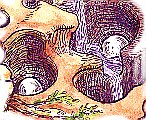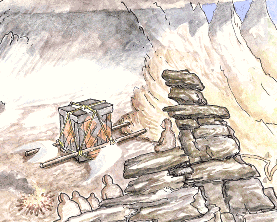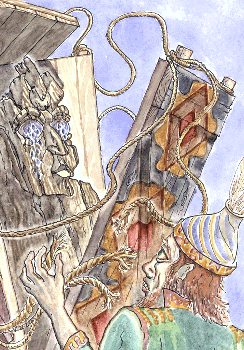
 |
A Himalayan Legend - 2 |

The day came when the Nangali were to descend with their God to re-enact, after a lapse of years, the ancient ritual of their tribe. A ceremonial guard of Vedmagoni warriors was sent up to escort the statue and to ensure that the priests made no premature alterations to its monetary value. Sedemichra encased the statue in a wooden case, in full view of the guards. The bearers took the case over the mountains along an ancient ceremonial route that led over a remote pass before descending steeply to the valley.
At the summit of the pass the priest called a halt. It was still before dawn and it would be dangerous to descend in the dark. The team rested for two hours before a small fire. Then, when the sun was well up they commenced the descent.
As the wooden case was borne into the main square of the old capital it was immediately surrounded by a force of the Vedmagoni, dressed in ceremonial robes that could be discarded at a nod from their leader, to allow unimpeded use of their weapons. Sedemichra bowed before the king and asked permission for his people to make a ceremonial dance before unveiling the statue.

The king assented and the priest called on the musicians and the dancers to begin. The elaborate knot dance is shown in an old painting on goatskin, part of the fragmentary saga of the tribe, which is known as the Nangayat and is preserved in caves in the mountains.
The rythm accelerated, the dancers became frenzied, the music louder and more sombre. The reed pipes and the narrow wooden trumpets of the mountain people combined to give a hypnotic quality to the music. The dance reached its climax with the dancers delivering their ends of the ropes to the priest. He handed the bundle to the king and said:
'Pull the sacred cords and the statue will be revealed'.
The king tugged at the cluster of yellow ropes and the cunning knots instantly unravelled. The sides and top of the box fell away and the statue was revealed. Water was pouring from the silver eyes and staining dark the grey, weathered wood of the face and breast. The king turned pale, his soldiers gasped in apprehension. The priest stepped forward and spoke in a high and resonant voice: 'The god has delivered judgement on the invader of the country which he guards with merciless power. Unless you and all your people leave the lands of the Nangali before midnight his awful vengeance will be unleashed'.

And so it was that with haste and confusion the Vedmagoni fled the land of the Nangali and the tribe regained their fertile meadows by the Ramagashana river.
That was the story I read in the notes and sketches of Wilhelm Froschfeld. He did not believe the story as a magic event. He attributed the first episode of weeping of the god, as we would, to condensation of water vapour from the warm steamy sickroom on the silver eyeballs, still cold from the mountain air. He was, however, puzzled by the apparently deliberate delay in unveiling the statue before the king of the Vedmagoni. The dance would certainly have built up the dramatic tension but Froschfeld discerned a physical reason for the delay. He thought that the priest had made a hollow in the top of the box which was filled with snow during the halt on the mountain top. The snow later melted and dripped through holes in the box. He realized the difficulty in orienting the box exactly enough to ensure an accurate drip onto the eyeballs and suggested that the priest had fixed slender threads from holes in the lid to the eyes, to conduct the meltwater. The dramatic and explosive unveiling had ripped away these threads, which would have been unnoticed among so many other ropes.
At this point in my studies in the library the rain had eased and I hastened to catch my train.
As I gazed out at the rain-greyed north German plain I conceived an alternative, much simpler explanation for the miraculous scaring away of the Vedmagoni. My version relies on a consideration of the way in which wood interacts with water vapour in the air.

This work is licensed under a Creative Commons Attribution-Noncommercial-No Derivative Works 3.0 License.